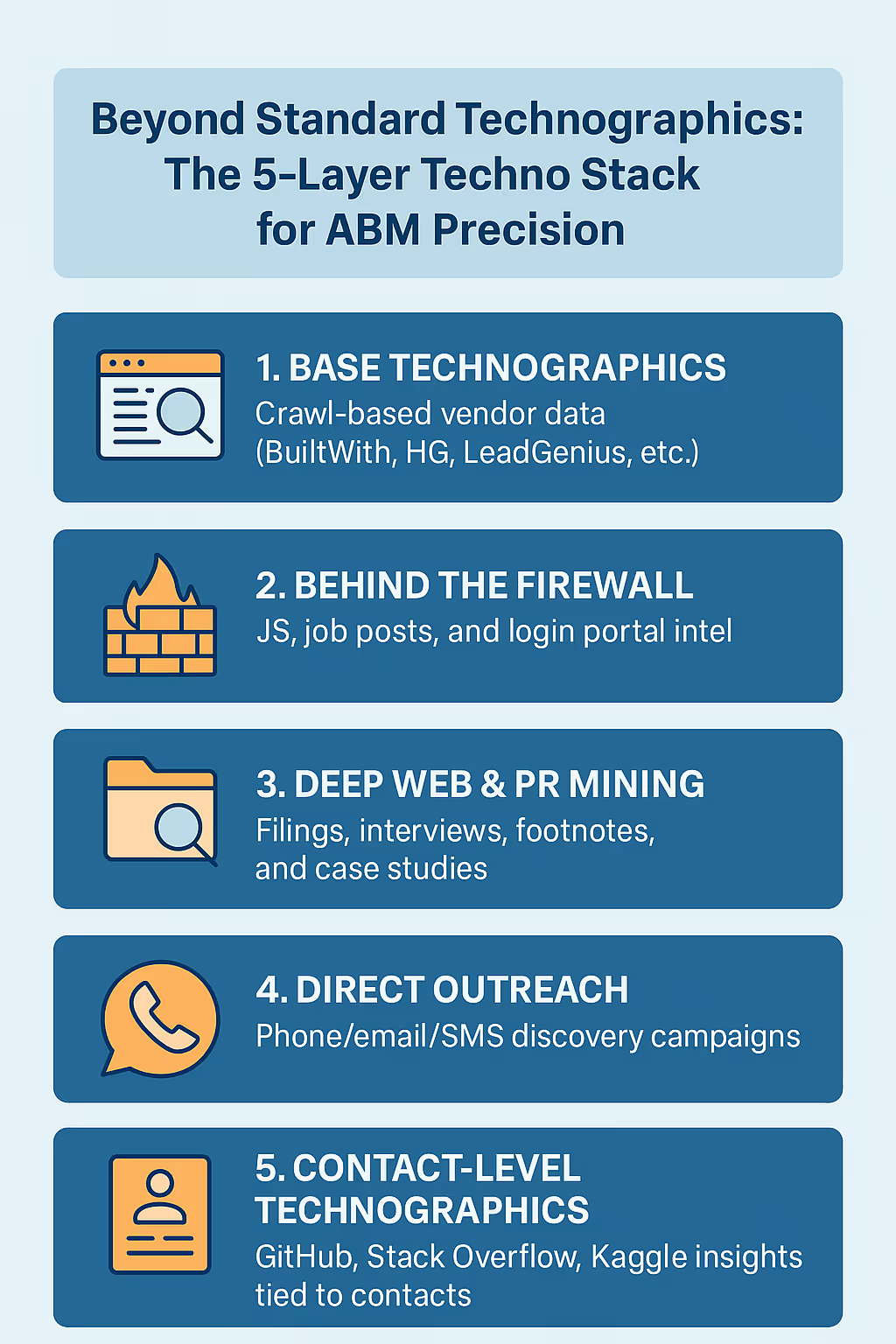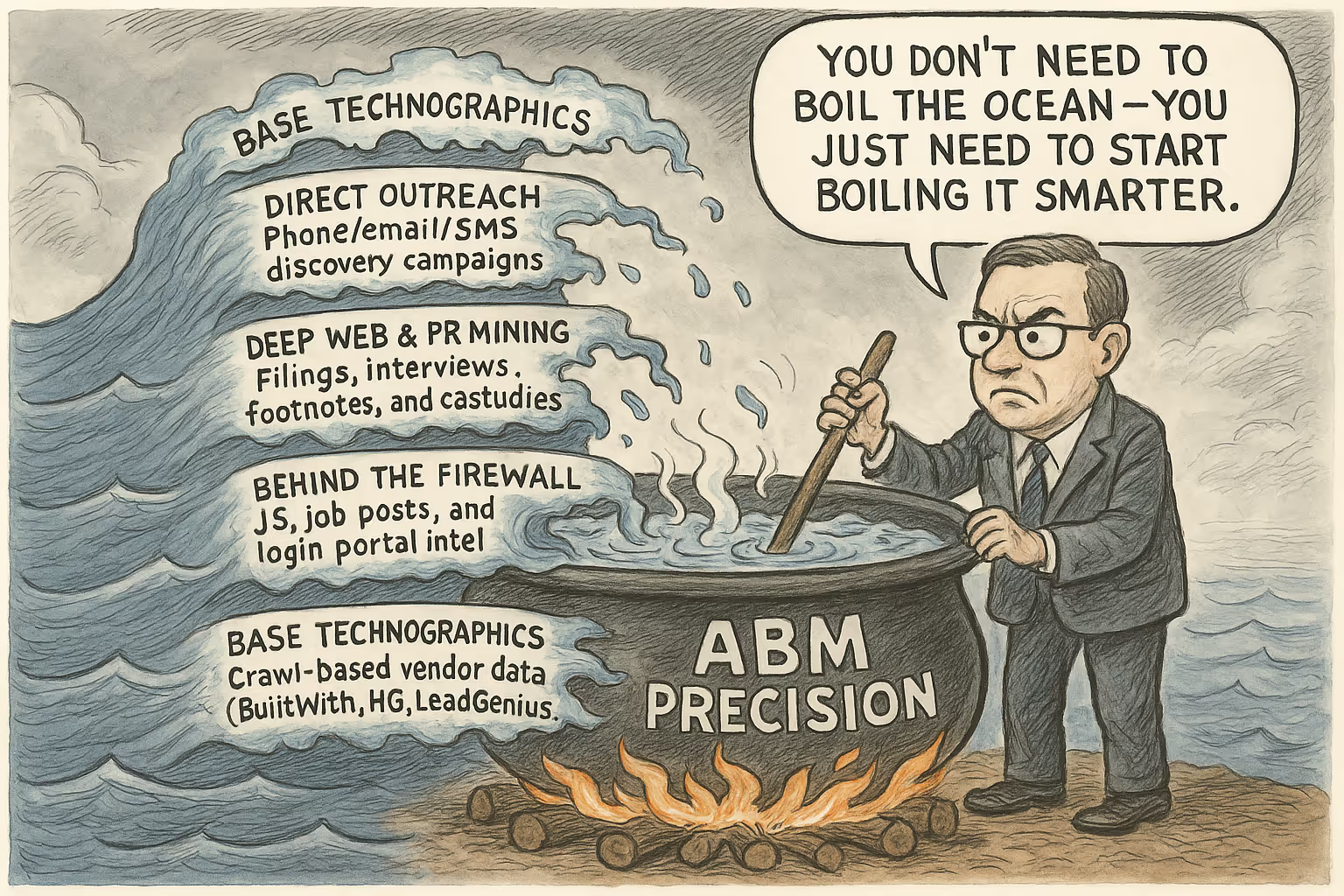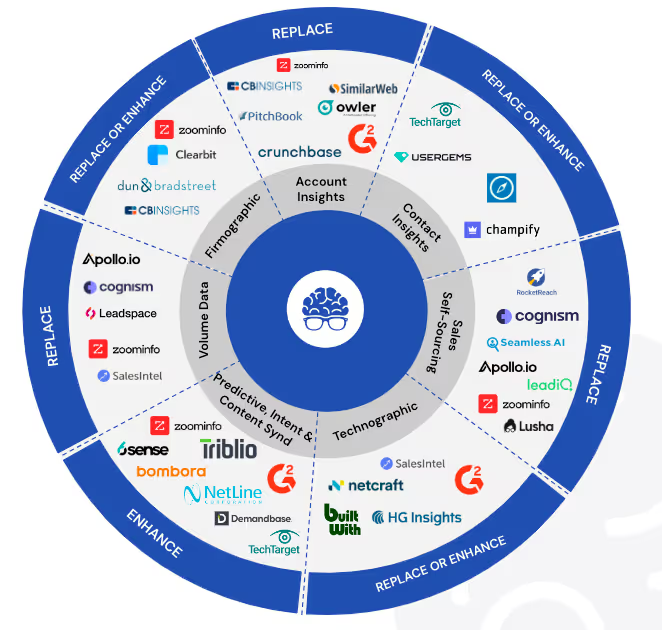If you’re running any form of ABM—whether it’s 1:1 strategic, 1:few industry clusters, or 1:many scaled—you already know that boiling the ocean isn’t a strategy. You’re locked in on a set of named accounts. Maybe it’s 500. Maybe it’s 5,000. Either way, you need more than just surface-level signals about those companies to drive true personalization, segmentation, and prioritization.
And that’s where standard technographics fall short.
Here’s how to go beyond surface-level data and start building real competitive advantage with advanced technographic strategy.
Step 1: Start With the Low-Hanging Fruit (But Don’t Stop There)
Let’s not throw the baby out with the bathwater.
Technographic tools like BuiltWith, HG Insights, Apollo, G2, and LeadGenius provide a solid first-pass. They’ll tell you what’s been picked up by crawlers, browser-side tech, and vendor reviews. It’s helpful, especially for identifying:
- Web infrastructure (e.g., Shopify, WordPress, HubSpot)
- Popular SaaS (e.g., Salesforce, Marketo, ADP)
- 3rd-party integrations and tracking scripts
But these sources largely rely on public-facing tech stacks—what’s visible on a website or declared in a review profile.
For real ABM impact, that’s just your launchpad. You need to dig deeper.

Step 2: Investigate What’s Behind the Firewall
Once you’ve ruled out who’s not using your competitor (e.g., you know they’re not on Paychex), the real question is: what are they using?
This is where most vendors can’t help you—but the opportunity to differentiate starts here.
Some examples:
- Job postings: If the company’s careers page lists a job for “Payroll Specialist – must be fluent in ADP Workforce Now,” that’s a data point.
- Embedded JS and APIs: Some customer portals leak fingerprints—QuickBooks payroll JavaScript, API endpoints calling Gusto, etc.
- Benefits portals: Many companies publicly link to “employee login” pages powered by providers like TriNet, Zenefits, or Paylocity.
This layer is often missed by public crawl vendors. You’ll need a provider like LeadGenius that specializes in real-time custom crawling and behind-the-login research to tap into these hidden gems.
Step 3: Mine the Deep Web: Filings, PRs, and Footnotes
If your target list is large enough (let’s say 5,000+ accounts), you’ll end up with 30–50% that are still ambiguous after the first two steps.
That’s your moment to get creative:
- 10-K and 10-Q Filings (for public companies) often name vendors in footnotes:
“Payroll services provided by Paylocity” or “HCM powered by UKG.” - Press Releases & Investor Decks: Look for partnerships, system migrations, and digital transformation announcements.
- CFO/HR Interviews or Case Studies: These often drop product names in passing.
These sources are not scalable with legacy systems, but they’re gold mines. The right data partner will use NLP-powered deep-web mining to flag these instances and tag your target accounts accordingly.
Step 4: Ask Directly (and Be Smart About It)
When all else fails, just ask.
Most BDR teams are underutilizing the power of focused outbound discovery. This isn’t about boilerplate “book a demo” emails. It’s about tailored, low-pressure information gathering:
- Phone Scripts for HR/Finance: “Hey, just doing some market research—curious, are you currently using any third-party payroll provider?”
- One-question Email/SMS Surveys: “Quick question—who handles your payroll and benefits today?”
Use a 2–3-touch cadence (e.g., voicemail → email → follow-up call) and you’ll capture a meaningful chunk of the unknowns. If you do this tactfully, it can even open doors for consultative selling down the line.
Step 5: Add Contact-Level Technographics (Not Just Company-Level)
Here’s where ABM becomes ABX.
Instead of asking “what’s this company using?” start asking:
“What is this person using?”
By parsing developer contributions on platforms like GitHub, Stack Overflow, and Kaggle, you can start to see clusters of skillsets tied to accounts:
- If 15 engineers at the same company are active in JavaScript repos using Firebase, that’s a hint.
- If DevOps leaders mention Terraform, GitHub Actions, or Azure DevOps in their bios or commits, you now know more about how they deploy and manage infrastructure.
- If data scientists have Kaggle kernels or notebooks using Databricks or Snowflake, that’s a tell.
All of this can be tied back to your ABM list, creating persona + intent + stack triangulation that dramatically boosts precision.
Wrapping Up: From Crawl to Custom
Technographics as you know them are aging out.
The new wave of ABM isn’t about mass-surveying the internet. It’s about going from generic to granular, from company to contact, and from assumed to confirmed.
This layered approach unlocks what most of your competitors will never see:
- The silent market share you can steal
- The hidden vendors you can displace
- The accurate segmentation that drives real pipeline
TL;DR: The 5-Layer Techno Stack for ABM Precision
- Base Technographics – Crawl-based vendor data (BuiltWith, HG, LeadGenius, etc.)
- Behind the Firewall – JS, job posts, and login portal intel
- Deep Web & PR Mining – Filings, interviews, footnotes, and case studies
- Direct Outreach – Phone/email/SMS discovery campaigns
- Contact-Level Technographics – GitHub, Stack Overflow, Kaggle insights tied to contacts
You don’t need to boil the ocean—you just need to start boiling it smarter.




